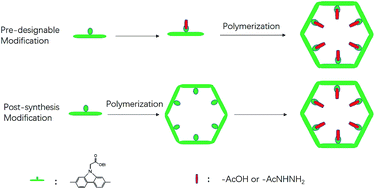Acid/hydrazide-appended covalent triazine frameworks for low-pressure CO2 capture: pre-designable or post-synthesis modification†
Abstract
Pore surface engineering in nanoporous organic polymers (NOPs) targeted for their different applications remains a critical challenge. Here we compare two classic modification strategies, i.e. pre-designable and post-synthesis modification, which allow controlled loading of functionalities onto the pore wall by anchoring ethyl ester, acetic acid or acetohydrazides for effective CO2 capture. The pre-designed acetic acid-appended or acetohydrazide-appended precursors permit the construction of covalent triazine frameworks (CTF-CSU36@pre and CTF-CSU37@pre) with walls to which an exciting content of functional units is anchored. Conversely, channel functionalization is made possible by facile hydrolysis or hydrazide reaction of a carbazole-bridged triazine framework with pendant ethyl ester (CTF-CSU20) to produce surfaces with desired acetic acid (CTF-CSU36@post) or acetohydrazide groups (CTF-CSU37@post). High-degree dense integration of functional groups on the channel walls proved the superiority of the post-synthesis modification relative to the pre-designable strategy. Porous monoliths with high capacity at very low pressures (5.7 wt% at 273 K/0.15 bar), excellent IAST ideal selectivity (CO2/N2 = 145.9) and reusability were created, demonstrating their great potential for gas storage and separation. Significantly, such tailor-made pore-wall functional engineering could be a facile and powerful strategy for broad applications of NOPs.



 Please wait while we load your content...
Please wait while we load your content...